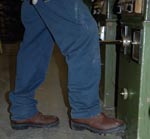
April 2010
- HAND PROTECTION:
Preventing Common
Infections
- EMPLOYEE GIFTS &
INCENTIVES: New Frontiers
for Safety Incentives
- WELLNESS: Boosting
Employee Engagement
- BUSINESS CONTINUITY:
Ready for Anything
Click here to subscribe.
Cover Story

By Jerry Laws
Manufacturing a protective boot that can meet exacting national standards is challenging enough. When the relevant industry adds its own performance testing to the mix, as the aluminum smelter industry around the world has done, the challenge grows — but this happens for all the right reasons.
Features
By Jerry Laws
The type and size of a company really don't matter because a well-executed safety incentive program will serve them well, says industry veteran Sean Roark, CPIM.
By Jerry Laws
It's clear that U.S. safety managers understand cash is a bad motivator of safer behaviors and performance on the job. Nine out of 10 potential customers he sees at industry trade shows accept that statement as a given, said Brian Galonek, CPIM, president of All Star Incentive Marketing of Fiskdale, Mass.
By Buck Peavey
Here is the wellness gig in a nutshell. Health care costs really are out of control. How do we win this out-of-control game?

By Matthew Wagner
Disposable nitrile, natural latex, and vinyl gloves, often referred to as thin-mil gloves, are used in a variety of distinct applications. Understanding the truths about glove performance is important in selecting the right glove for each application.

By Donald F. Groce
When illnesses strike — such as seasonal flu, H1N1, or MRSA — how do you protect your workers and do your part to stop contagious infections from spreading to unsuspecting workers and crippling the productivity of your organization, with high absenteeism from sick leave or mass panic?

By Jerry Laws
Today's on-site occupational health centers are the fruition of an evolution that began soon after the OSH Act was signed into law 40 years ago, when the chief task involved was treating work-related injuries. Medical surveillance was part of the package, then and now, but nonwork- related acute care and health management are now important components, said Stu Clark, executive vice president of Comprehensive Health Services Inc. (CHS), based in Reston, Va.
By Helen Pieron
Cutting back on safety expenses could amount to gambling with not only the health and well-being of workers, but also with profits and perhaps the company itself.

By Marc Barrera
At approximately 10 a.m. on March 25, 2009, an F-22 crashed northeast of Edwards Air Force Base, killing David Cooley, 49, of Palmdale, Calif., a 21-year veteran test pilot. During the days of World Wars I and II, this may have been all too common an occurrence with test pilot deaths occurring weekly, but today, with advances in safety and technology, a test pilot's death happens on the average of once every two to three years.
By Stephanie Williams
Being prepared for an unexpected disaster requires planning well in advance in order to manage any emergency situation. Whether it is a natural, weather-related, man-made, or technological disaster, the key to survival lies in your pre-disaster efforts. Taking the time to assess the company's functions, develop plans to keep the business operating, detail strategies to lead recovery, and conduct employee training can make the difference between survival or closure for a business.

By Jeff Duff
What is the big deal about constructing, operating, and servicing a wind turbine? Ask anyone who has been involved in this industry for more than 20 years, and he will describe a time that is different from today only in the breadth and scale of these renewable energy-generating machines.
Departments
By Robert Pater
Are there people in your company who are working inflamed? Angry, hot around the collar, on guard, suspicious, untrusting, disbelieving, on edge, ready to react? All are potentially dangerous to their company's smooth functioning — and to their personal safety.